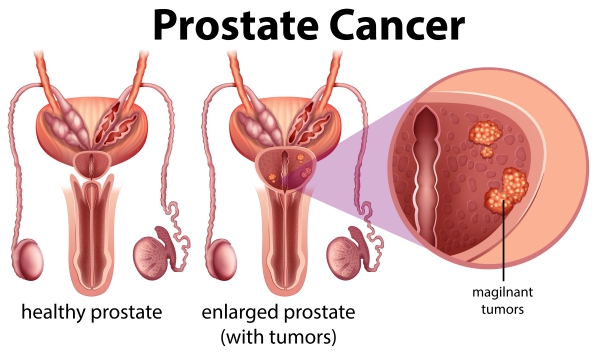What is Benign Prostatic Hyperplasia?
The prostate is a gland only found in the male reproductive system. It wraps around your urethra which is a tube that carries urine from your bladder and through the penis. The function of the prostate is to make a fluid which mixes with sperm to form the semen.
Benign prostatic hyperplasia (BPH) is when the prostate gland enlarges. This leads to the compression of the urethra causing problems with urination. This condition usually occurs in men aged greater than 50 years old. As the name suggests, it is a benign condition meaning that it is not cancerous. Even if the two conditions can arise concomitantly, BPH does not cause or lead to cancer.
In the United States, about 70% of men aged between 60-69 years and 80% of men aged greater than 70 years have some degree of BPH.
There are many treatment possibilities available depending on the extent of your symptoms and the size of the prostate.
Causes and risk factors
The exact cause of BPH is not known. However, it has been shown to be associated with certain factors which increases your risk of having the disease. These include:
- Genetics: Studies have shown that having family members with BPH may make you more susceptible to having it because of your genes.
- Family history of cancer: You are at higher risk of having BPH if you have a family history of bladder cancer. Ironically, it is not associated with a family history of prostate cancer.
- Metabolic syndrome: Obesity, diabetes, hypercholesterolemia and hypertension increases your risk of having BPH.
- Caffeine consumption: Excessive consumption of caffeine is associated with a higher risk of having BPH.
- Physical activity: Lack of physical activity puts you more at risk of developing BPH.

Signs and symptoms
Since the prostate gland is wrapped around your urethra, its enlargement will lead to the compression of the urinary tract leading to bothersome urinary symptoms such as:
- Frequent need to urinate especially at night
- Difficulty to initiate urination
- Weak or interrupted stream of urine
- Dribbling at the end of urination
- Leakage of urine
The symptoms tend to progress slowly with time especially in older people. However, in some people, the symptoms may resolve on their own. Some people may not even notice the symptoms while they can be very problematic for others. In some people, it can even progress to urinary retention where the person is no longer able to urinate.
The above symptoms can also occur in other conditions such as prostate cancer, bladder cancer or kidney stones. Therefore, it is very important to seek medical advice once you start noticing these symptoms for proper evaluation.


Making a diagnosis
To make the diagnosis of BPH, it all starts with a good detailed history. Your doctor will then examine you. He/she will perform a digital rectal examination. This is done by inserting a finger into your rectum to feel your prostate and check for any enlargement or other abnormalities. Other tests may be done including:
- Urinalysis: A urine sample is taken and sent for examination. This will indicate whether there is the presence of an infection in your urinary tract.
- Prostate-specific antigen (PSA) level: This is a protein produced by the prostate. In BPH, the level of PSA will be high.
- Post void residual volume: This test is used to measure the amount of urine left in the bladder after urination.
- Urinary flow test: this measures the strength of the urine stream.
- Ultrasound: in this test, a probe is inserted into your rectum to visualize the prostate.
- Biopsy: Samples of your prostate is taken using a needle under ultrasound guidance. The samples are then sent to be examined for the presence of cancer.
Treatment of BPH
Treatment may be required in certain cases in order to reduce the symptoms and improve the quality of life. These include medications and surgery.

Men with mild BPH may not need any treatment. However, it is important to wait and watch for any changes in the symptoms.
People with more severe symptoms usually will need treatment for relief.
There are several medicines that can be used to treat BPH. These include:
- Alpha blockers: These medications work by relaxing the muscles found in the prostate. This will relieve the compression on the urethra, thus allowing urine to flow easily. Some examples include terazosin, tamsulosin and doxazosin. Some side effects caused by these drugs may include dizziness and low blood pressure. You should not be taking terazosin or doxazosin if you take medications for erectile dysfunction.
- Alpha-reductase inhibitors: This class of medication works by stopping the enlargement of the prostate or even causing it to shrink. Examples include finasteride and dutasteride. Some side effects may include decreased sex drive, problems with erection or ejaculation or feeling depressed.
Surgical procedures may be required if medications fail to control the symptoms. These include:
- Transurethral resection of prostate: Special instruments are inserted into your urethra till they reach the prostate. The prostate is then removed in small pieces. This is done under anaesthesia and can lead to certain complications such as bleeding, sexual dysfunction or problems with urination.
- Ablation of prostate: in this procedure, the prostate is destroyed using electricity, light or heat energy. It is accompanied by less complications compared to transurethral resection of prostate.
- Transurethral incision of the prostate: In this minimally invasive procedure, the prostate is not removed. Instead, the urethra is widened.
- Prostatectomy: In this surgical procedure, the whole prostate is removed. It is usually recommended in men who are healthy and have a very large prostate.

Lifestyle changes can also help in reducing the symptoms of BPH and its progression. Some of the changes include the following:
- Reducing the amount of fluid consumed a few hours before going to bed or going out
- Avoid caffeine and alcohol
- After emptying your bladder, wait for a few moments and try to urinate again.
Complications of BPH
Complications of BPH may include the following:
- Urinary retention: In patients with urinary retention, a catheter may be placed in order to relieve the pain and drain the urine out.
- Urinary tract infections: Retention of urine can increase the risk of having urinary tract infections.
- Bladder stones: Incomplete bladder emptying can lead to the formation of bladder stones.
- Bladder damage: Constant stretching of the bladder wall can cause damage and weakening of the bladder muscle.
- Kidney damage: Urinary retention causes pressure in the kidneys and leads to damage to the organ.
Prognosis of BPH

BPH has a good prognosis. Even if it can cause disturbing symptoms in the long run, the condition is benign and can be managed with a variety of medications and surgeries.

Source:
Parveen, K. and Michael, C., 2017. Kumar & Clark's Clinical Medicine. 9th ed. The Netherlands: ELSEVIER.
McVary, K., 2019. Epidemiology and pathophysiology of benign prostatic hyperplasia.
McVary, K., 2019. Clinical manifestations and diagnostic evaluation of benign prostatic hyperplasia.
McVary, K., 2020. Medical treatment of benign prostatic hyperplasia.
McVary, K., 2020. Surgical treatment of benign prostatic hyperplasia (BPH).



